![]()
![]()
![]()
Use LEFT and RIGHT arrow keys to navigate between flashcards;
Use UP and DOWN arrow keys to flip the card;
H to show hint;
A reads text to speech;
88 Cards in this Set
- Front
- Back
|
SHOULDER GIRDLE
1. Show the following landmarks and give the soft tissues (muscle, tendon, ligaments) attached: |
Supraclavicular space, Scalene muscle group & Platysma muscle, Neurovascular bundle in thoracic outlet tunnels, Sternoclavicular joint, sternum, 1st – 8th ribs, Clavicle, Infra-clavicular space, pectoralis clavicular origin, pectoralis muscle group, Coracoid process and ligamentous/muscle insertions, Acromion and ligamentous Insertions, Acromioclavicular joint, Anterior glenohumeral joint, Greater tubercle of
the humerus, Long head of biceps tendon, Bicipital groove, Subscapularis, Supraspinatus and Infraspinatus insertions, Lateral glenohumeral joint, A/M/P Deltoid muscles and insertion, Pectoralis insertions, Latissimus dorsi insertion, Subscapularis muscle, Serratus anterior muscle, Lateral border of scapula, Latissimus dorsi muscle, Tricep muscle and insertions, Teres minor muscle and insertion, Teres major muscle and insertion, Infraspinatus muscle, Posterior glenohumeral joint, Spine of scapula, Spinoscapular notch, Supraspinatus muscle and tendon, Upper trapezius muscle and insertion, Superior angle of scapula and levator scapulae muscle, Medial border of scapula and Rhomboid muscle, Inferior angle of scapula, Middle and Lower trapezius muscles. |
|
|
2. assess scapulo-humeral rhythm in abduction and in adduction return
|
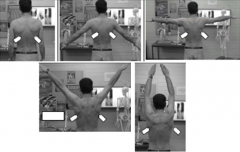
|
|
|
3. assess scapulo-humeral rhythm in flexion
|
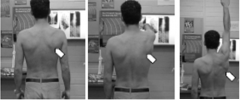
|
|
|
4. perform long axis compression joint play of the G/H joint
|
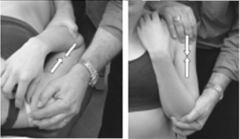
|
|
|
5. Motion palpate long axis compression of the G/H joint in coupled positions (45 & 90)
|
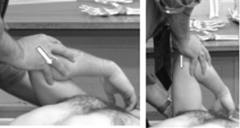
|
|
|
6. perform P-A/A-P glide of the G/H joint
|
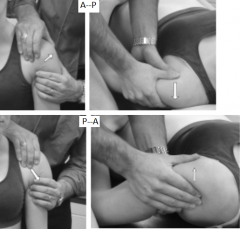
|
|
|
7. perform long axis distraction joint play of the G/H joint
|
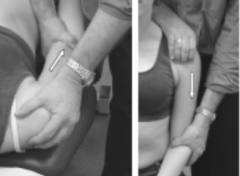
|
|
|
8. perform ER/IR motion palpation of the G/H joint (Neutral and abduction)
|

|
|
|
Perform Kinetic Chair Shake
|
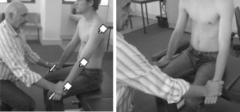
|
|
|
9. perform lateral glide of the G/H joint
|
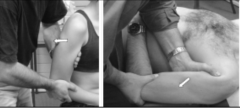
|
|
|
10. perform posterior/anterior and lateral glide of the G/H joint
|

|
|
|
11. motion palpate inferior glide in abduction of the G/H joint
|
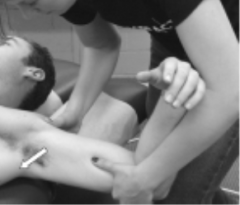
|
|
|
12. motion palpate inferior glide in flexion of the G/H joint
|
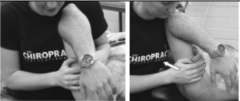
|
|
|
13. perform the protraction/retraction motion palpation of the clavicle
|

|
|
|
14. perform scapula humeral rhythm in abduction for the clavicle
|
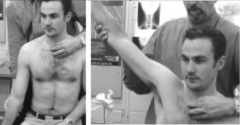
|
|
|
15. perform S-I and I-S rotation with G/H flexion/extension for the clavicle
|

|
|
|
16. perform A-P-A joint play of the A/C joint
|
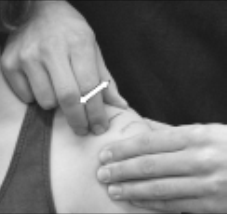
|
|
|
17. perform I-S-I joint play of the A/C joint
|
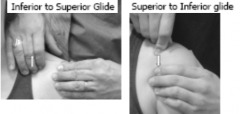
|
|
|
18. perform a motion palpation assessment of the scapula
|
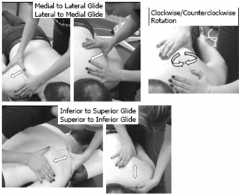
|
|
|
19. perform I-S-I glide of the SC joint
|

|
|
|
20. perform A-P-A joint play of the S/C joint
|

|
|
|
MUSCLE TESTS
21. perform the neck flexor muscle test – bilateral |
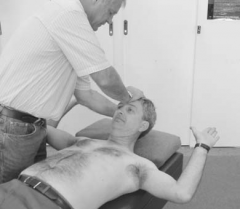
|
|
|
22. SternoCleidoMastoid
|

|
|
|
23. Neck Extensors
|
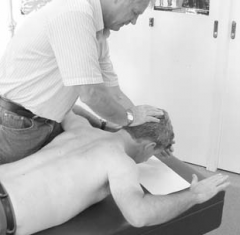
|
|
|
Trapezius - Upper, Middle, Lower
|

|
|
|
Rhomboids
|

|
|
|
Levator Scapulae
|

|
|
|
Teres Major
|
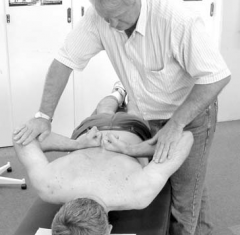
|
|
|
Coracobrachialis
|
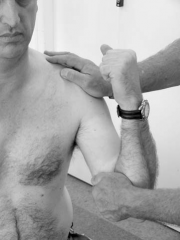
|
|
|
Latissimus Dorsi
|

|
|
|
Deltoid- Anterior, Middle, Posterior
|

|
|
|
Supraspinatus
|

|
|
|
Infraspinatus
|

|
|
|
Subscapularis
|
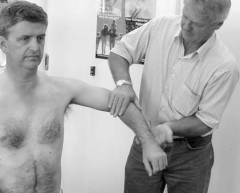
|
|
|
Teres Minor
|
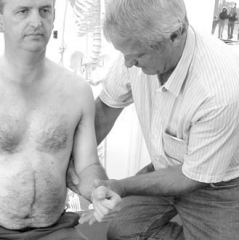
|
|
|
Pectoralis Major - Clavicular & Sternal
|
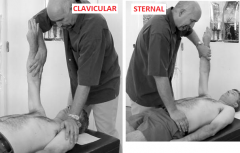
|
|
|
Serratus Anterior
|
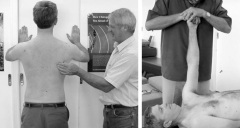
|
|
|
Anterior Dislocation tests
1. perform the Anterior Apprehension test |
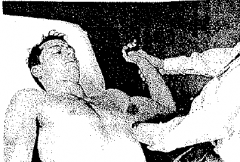
|
|
|
2, Dugas test
|
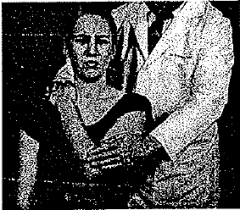
failure to bring elbow to chest
|
|
|
perform/discuss the Hamilton’s ruler test
|
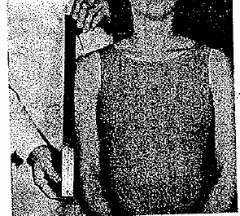
positive when the tip of the acromion may be joined to the lateral epicondyle of the humerus with a straight line
|
|
|
perform/discuss Calloway’s test
|
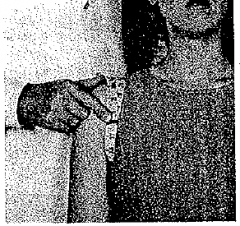
Inc. meacurement
|
|
|
perform/discuss Bryant’s sign
|

Low axilla fold
|
|
|
Anterior Instability
- Perform the Anterior Drawer test |
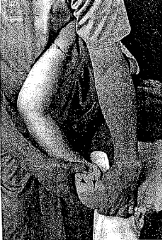
|
|
|
perform the Rockwood test
|

|
|
|
perform the Rowe test for anterior instability
|

|
|
|
perform the Anterior Release test
|
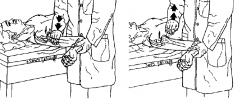
|
|
|
perform the Posterior Apprehension test
|
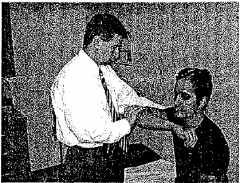
Stabilize scapula & Elbow, push back
|
|
|
perform the Posterior Drawer test
|
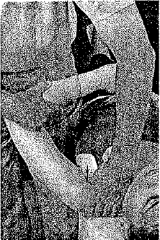
|
|
|
perform the Posterior-Inferior Pressure test
|
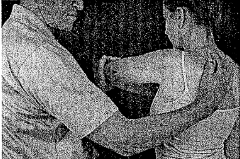
|
|
|
Inferior Instibility
- perform the Sulcus Sign/Test |
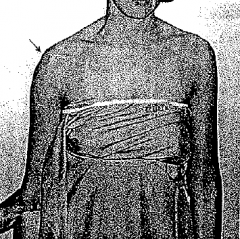
|
|
|
perform the Load & Shift test
|
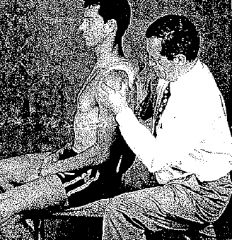
LAD or LAC, with A-P-A
|
|
|
Subacromial Bursitis
- perform Dawbarn’s sign |
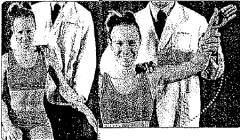
Pain decreases on abduction
|
|
|
Supraspinatus tendon impingment
- perform the Hawkins-Kennedy test |
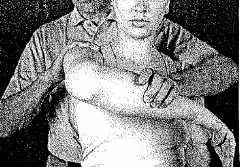
|
|
|
perform the Neer test
|
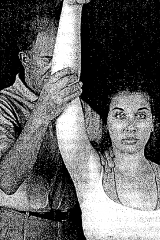
stabilize and hold scapula down
|
|
|
perform the Impingement sign for supraspinatus & biceps tendon impingement
|
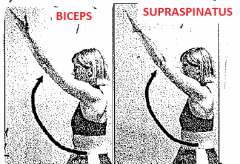
IR- supra, ER- infra
|
|
|
perform the Scapular Assistance/ Retraction Test
|

|
|
|
Rotator cuff tendinopathy
- perform the Empty Can Test |
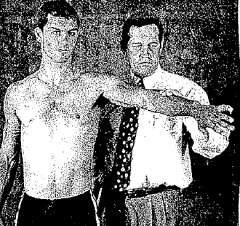
Supraspinatus
|
|
|
perform the Drop Arm Test
|
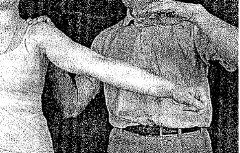
Supraspinatus
|
|
|
perform the Lift-off sign
|
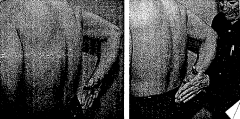
subscapularis
|
|
|
Rotator cuff impingment/tendinopathy
- perform/describe the Codman’s sign |
Over activity of the trapezius muscle
|
|
|
perform Apley’s scratch test
|
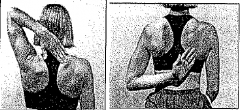
|
|
|
Labral tears
- perform the O’Brien’s test |

|
|
|
perform the Clunk test
|
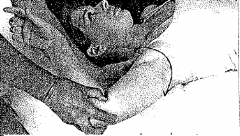
Abduct, ER, LAC & circumduct
|
|
|
perform the Crank test in several positions
|
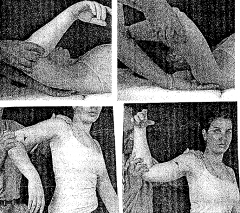
90 Abd, LAC & IR--ER
|
|
|
perform the Anterior Slide Test (SLAP)
|

|
|
|
perform biceps load test II
|

120 ABD, ER, Bicep resistance
|
|
|
perform the Resisted Supination - External Rotation test
|
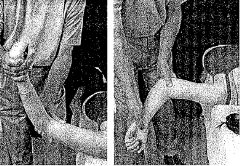
supination resistance
|
|
|
Bicep Tendinopathy
- perform Yergason’s test |

|
|
|
perform Speed’s test
|

|
|
|
perform Ludington’s test
|
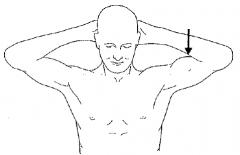
observe contraction
|
|
|
Tranverse Ligament Rupture
- perform the Transverse humeral test |

|
|
|
perform the Biceps tendon instability test
|
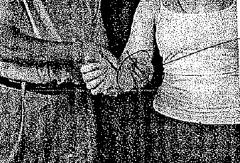
|
|
|
Mobilizations
- perform parts 1-4 – sidelying shoulder mobilisation |
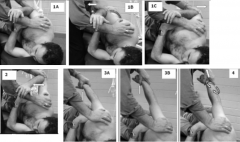
|
|
|
perform a supine shoulder extension and flexion technique
|

|
|
|
perform supine internal/external rotation technique
|
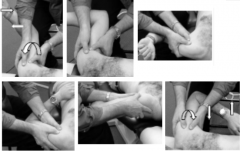
|
|
|
perform supine shoulder circumduction technique
|
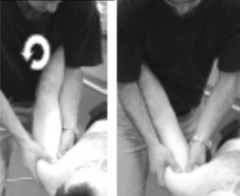
|
|
|
perform the prone shoulder circumduction (glenohumeral) technique
|
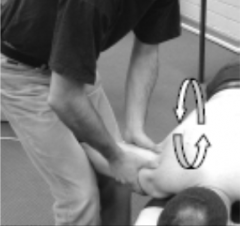
|
|
|
perform the prone shoulder circumduction (scapulacostal joint) technique
|
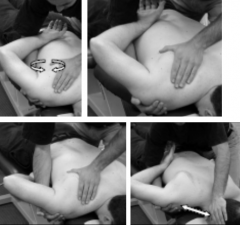
|
|
|
Adjustments
- perform anterior humerus subluxation technique & separation technique |
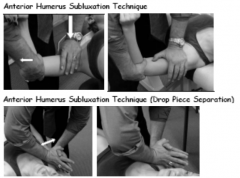
|
|
|
perform supine/prone superior humerus subluxation technique
|

|
|
|
perform the sitting superior humerus subluxation technique
|
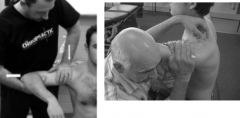
|
|
|
adjust an inferior humerus subluxation (Medial & Lateral)
|
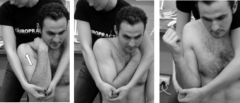
|
|
|
adjust a posterior humerus subluxation
|
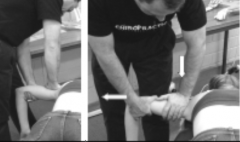
|
|
|
perform the sitting superior clavicle subluxation adjustment technique
|
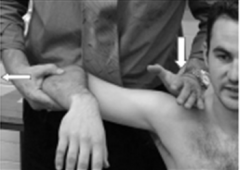
|
|
|
perform the supine clavicular raise technique (depressed clavicle technique)
|
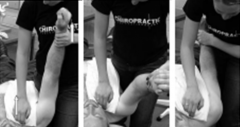
|
|
|
perform sitting sternoclavicular mobilisation technique
|

|
|
|
perform anterior sternoclavicular subluxation technique
|

|
|
|
adjust a superior/inferior/medial/lateral subluxation of the scapula
|
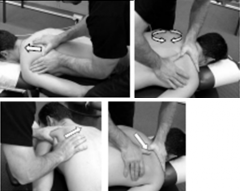
|

